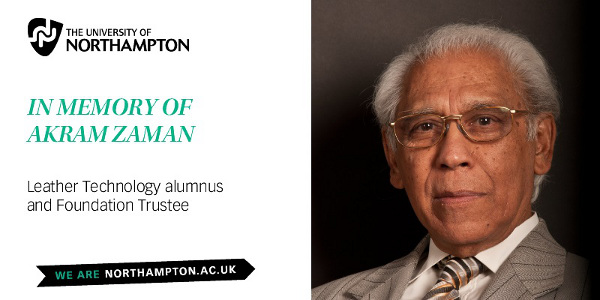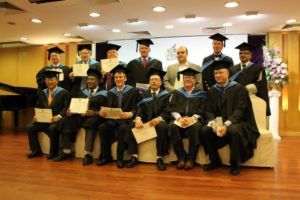POSTED ON
Three items below
Condolences to the Family of Akram Zaman

It is with sadness we were informed of the passing away of Leather Technology alumnus Akram Zaman on Saturday 19 April 2014.
The University of Northampton and the Institute for Creative Leather Technologies (ICLT) would like to recognise not only his support for the University of Northampton through philanthropy but also his passion and commitment to the leather industry and the county of Northamptonshire.
We pass on our sympathy to his family and friends.
Kind regards
Daryn Castle
Alumni Officer
University of Northampton
POSTED ON
Water is not the best tool for tanning
It feels like we have been trying to replace water as the vital fluid in tanning fir decades. Dyeing with the Swiss Multimac machine was just a typical example of many ideas intended to avoid leather having to processed in an aqueous bath. The patent for this was applied for in 1986. I last saw one lying rusting away in a field outside Oporto in Portugal. At the end of the day water remains a key material and the effective work being done today in tanneries is a reduction in its use, using it better and cleaning it more effectively.
Yet at the 117th edition of the SLTC conference on Saturday we heard the first moves in an approach from the University of Leicester. Professor Andrew Abbott gave the Procter Memorial Lecture on “Ion-age Leather Processing – a Step Change in Technology”. Part of the concept is to design new materials specifically to carry chosen chemicals into leather, but not on the basis of the material just being a solvent that carries the material in and then needs cleaning up after.
If I understood it correctly using eutectic solvents which can be cheap, non flammable and biodegradable we can include active ingredients such as chromium and dyestuffs into the liquid rather than dissolving it as a solvent. Mimosa was also rested. All these are still at small stage testing for feasibility but in each case penetration was quick and the early indications are first of viability but then if both greater process speed and decreased effluent. The system has been bulked up to work commercially in immersion coating, electroplating and electro polishing so taking it further in leather processing looks to have some realistic potential. It is good to see that an SLTC conference can still come up with creative new ideas that put it at the leading edge of thinking.
A few years ago it looked like the SLTC would quietly wind down suffering from disinterest from the much reduced UK trade and wind down using up its reducing funds having an annual party for retirees and publishing the journal. Yet, perhaps linked to the return to Northampton, now the SLTC is back amongst the living and really moving forward. There is a real dynamic in the organisation and the conference clearly has regained the support of the industry and of Corium students at Northampton. Hopefully this means that all students will be persuaded to join the Society and stay members for their entire careers, just as so many of our older colleagues have done. Being a Corium club member and an SLTC member should be two strong outcomes of time in Northampton.
Mike Redwood
July 27th 2014
POSTED ON
Northampton is a lot more than leather
While we like to think of leather as the only worldwide business at the University of Northampton this is a long way from the truth. From podiatrists in Hong Kong to lift engineers in every country which has tall buildings Northampton trained staff are to be found. Waste management has big programmes in Africa and works all over the world and Fashion has long been working in Sri Lanka and China amongst other places.Yet by far the most important international programmes run by the University in terms of both numbers and income are those from the Northampton Business School.
So the new, more joined up, University approach which is starting to find the logical overlap that exists in all these subjects is an exciting situation as we are really the only institute in the world offering this sort of combined working and thinking, which is just what the leather industry needs and what is happening in industry right now. We have been seeing not only consolidation but also reconfiguration in the total leather industry for some years now and the next decade looks no different. Just as valuable, and important for leather is the fact that working with the other areas of the university to improve the offer helps to make teaching leather itself more viable. However important we tanners might like to think ourselves we are a small industry and teaching leather is expensive as it requires not just laboratories but a tannery and all that goes with it. A big expense for fifty or sixty students and only possible if short courses for big numbers of others who need a little knowledge of leather can run alongside it. That way we can afford to keep the fundamental tannery technician and tannery chemist training growing which is an area of steadily increasing demand. Alternate courses in the old European leather schools have nearly all been lost and it does not look as though many of the other international schools, apart from Brazil, are quite ready to fill the gap.
And equally important is that all of us who work in leather use all our skills to help open doors worldwide to let other parts of the University gain access to sell their courses. Leather may offer something unique to the University but we cannot keep hoping for the support of the University if we do not help it extract meaningful value from that uniqueness.
Outstanding Alumni

So it is really good to see the University run a degree ceremony for Hong Kong business graduates the evening before the start of the APLF fair. And this year to take the opportunity to use it as an opportunity to properly acknowledge with Honorary Degrees those of our Alumni who graduated many years before we became a degree awarding University and have subsequently made a significant contribution to the industry. One thing that is clear is that our alumni are special. There is a chap in London who calls himself the special one, but he needs to make a trip to Northampton to learn what being truly special means. Northampton leather graduates span the world from America to New Zealand, cover every aspect of the supply chain from raw to retailer and beyond. Their knowledge of leather and business stands out, along with a quite outstanding comradeship that is the envy of every alumni group.
So on Sunday last the University was proud to award degrees to:
David Burgess
Barney Crawford
Sateesh Damle
John Ettling
Geoffrey Githinji
Reginald Hankey
Jon Hopper
Iain McFadyen
Steve Miller
Jonathan Muirhead
Richard Pai
Juan Manuel Salazar
Stephen Trantum,
Christopher Tysoe
This is an amazing list of senior executives who continue to drive the leather industry towards being one of the cleanest and best sustainable processing industries anywhere. The transformation in product and processing they have overseen in the last two decades has been quite amazing.
At the same event the University also awarded an Honorary Doctorate to Derek Dickens for his lifelong support for the leather industry. Derek founded the Hong Kong Leather Show thirty years ago this year at a time when the industry was floundering as it tried to engage in the newly emerging Asian markets. In so doing he created an effective catalyst for all the transformation that was to follow and a trade show that continues to evolve so that the 2014 event was just as relevant and vital to the industry today as the first in 1984.
ADDENDUM: Very sadly Steve Miller’s Degree was awarded posthumously and was received on behalf of his family by Guilherme Motta of JBS